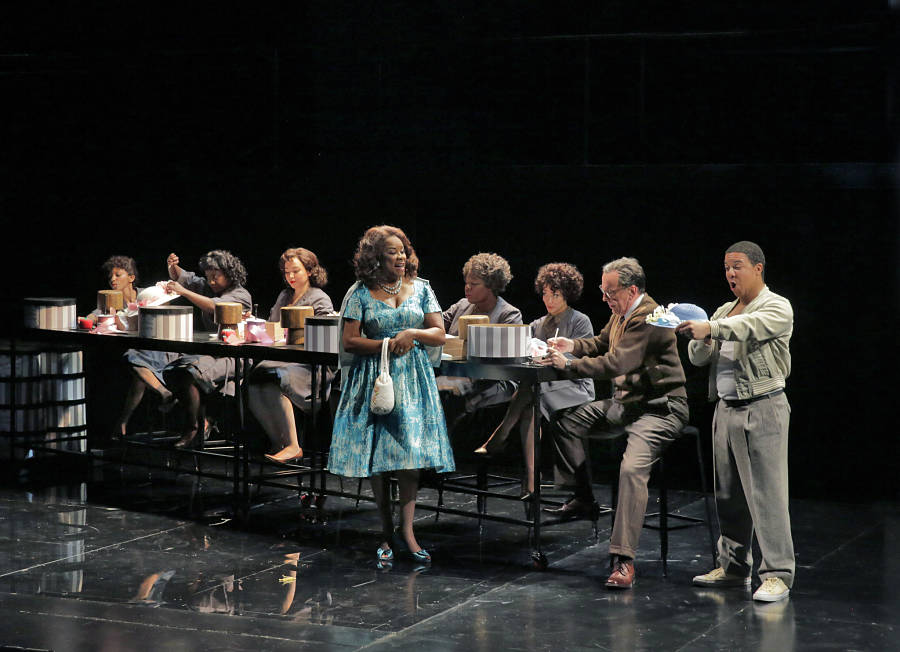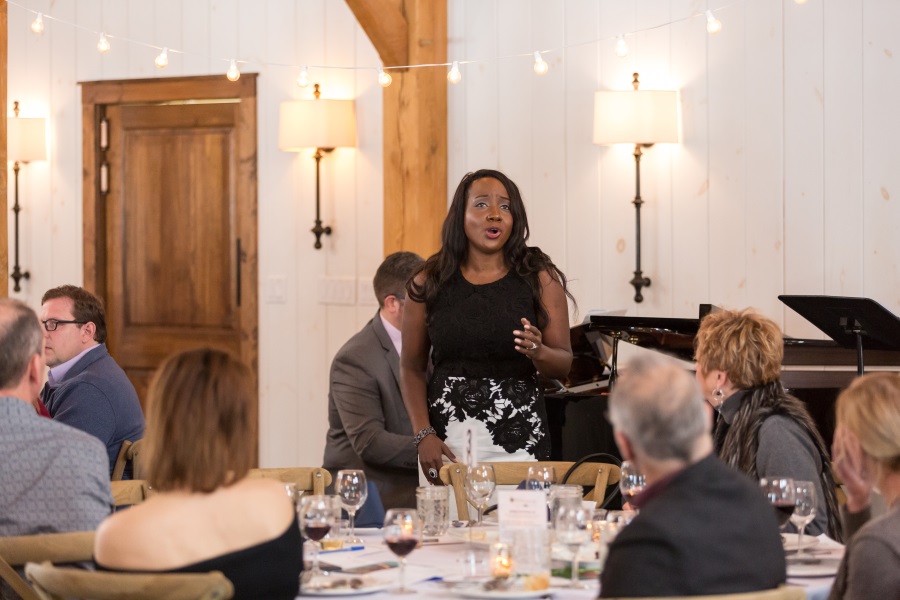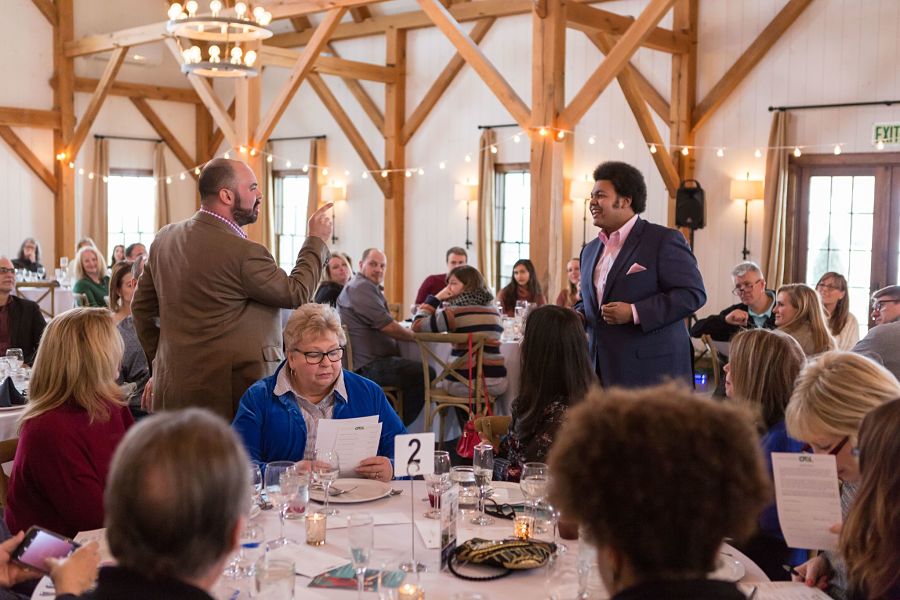How do you fill a leaking bucket?
Metaphorically at least that’s the problem that arts organizations around the country are facing as their core audience ages and dwindles.
“We call this problem the ‘leaky bucket,’ which is a good metaphor to describe the challenge,” says Andrew Jorgensen, general director of Opera Theatre of Saint Louis since 2018. “The traditional subscription audience is declining as people age out of participation. As we lose audience members, are we refilling the bucket rapidly enough that we are able to continue our enterprise? That’s the basic question. Can we continue to find and nurture new audiences?”
These subscribers who are leaving were often buying season tickets at higher prices, and it takes a “mega-subscriber” to replace them. Caron House, Opera Theatre’s former assistant director for development, estimates that it takes about three new subscribers to replace the loss of one of those loyal core audience members. Opera Theatre understandably found itself unable to keep up with this pace of replacement. So when they heard about the Wallace Foundation’s Building Audiences for Sustainability initiative, designed to address this very problem, they jumped at the chance to participate, as one of 25 performing arts organizations in the program.
The initiative kicked off in 2015, at a time when the company had seen a 10 percent decline in attendees. One of its strategies for drawing in new audience members was establishing an engagement and inclusion task force and starting a Young Friends program, which offered discounted tickets. OTSL also revised the company’s mission statement, adding the directive to “connect diverse audiences from across the region and around the world through the power and beauty of live opera.”
That was a fine effort, but as Joe Gfaller, former director of marketing and communications for OTSL, admits, “We were doing very little in the way of research.” The Wallace Foundation grant allowed OTSL to conduct market research to discover what motivated new people to come to the opera and to get people coming back. These are some of the most important takeaways.
1. You don’t have to paint with a broad brush.
Many opera companies do large-venue simulcasts to attract new audience members, so the first idea Opera Theatre investigated was doing their own simulcast in St. Louis’s Busch Stadium. The hope was to attract 30,000 people and convert perhaps one or two percent of them to ticket buyers. With Wallace support, OTSL conducted a survey to find out if the idea had legs. They discovered people wanted a “unicorn”: a famous opera, chopped down to 90 minutes, that was also a live broadcast. This was a non-starter, as the company could either give people a pre-filmed and edited opera or a full-length live broadcast, but not both. What’s more, when they talked to other companies that did simulcasts, none mentioned that it brought in long-term audience members. These findings gave Opera Theatre the confidence to jettison the idea.
This is exactly what Wallace Foundation wants grantees to do. “One framework that Wallace Foundation applies to their work is ‘continuous learning’,” says Bahia Ramos, director of arts at the Wallace Foundation. “We’re learning our way through a process of experimentation, reflection, assessment, and action.”
2. Find out why people aren’t going.
“I don’t have a ball gown,” one woman said when asked why she doesn’t go to the opera. She was in one of the many focus groups that Opera Theatre held to find out what kept people away from the opera. Another common sentiment? “I’m not rich enough for the opera.”
“People envisioned the trope that was created by Pretty Woman,” Gfaller says, “where you need to find Richard Gere to buy the most expensive gown and the most expensive jewelry for you if you’re going to go to the opera.”
Many also assumed the operas were all in Italian or French or another language they didn’t know. Opera wasn’t just for the highly educated—it was for the excessively educated, “the true snobs.”
But no one attending Opera Theatre wears a ball gown; most dress like they would for an outdoor summer wedding. And all of the operas there are performed in English.

So how do you show people that opera isn’t stuffy? Opera Theatre took a multi-pronged approach. One cheap and effective solution was to hire a photographer to take “pop-up paparazzi” shots of real-life opera attendees and post them on Facebook and Instagram. So far the photos have reached more than 26,000 people.
3. Get local—and invite engagement.
Another approach is to go out into the community.
In St. Louis, neighborhoods matter. Telling people that they are welcome to come to Webster Groves, a predominantly white suburb, to check out OTSL is not enough to actually get a cross-section of St. Louis society in the door. To diversify, Opera Theatre would have to take opera to the people.
So Opera Theatre created Opera Tastings. Hosted in a local restaurant or venue, the evening pairs 11 samples of food or drink with 11 operatic excerpts. The evenings have taken place all over St. Louis: in predominantly Black neighborhoods, in Chinatown, in Southern Illinois, or as far away as Columbia and Fayetteville, Mo. (120 miles and 145 miles, respectively).
“If the intent is to draw people in who surround you, then most of our organizations are finding that they have to be more present in the community,” says Ramos. “It’s how you build relevance. It’s how you show the work.”
Attendees are given information about the food, drink, and operas, and are encouraged to fill out an opinion card noting which arias they liked and which they didn’t.
The comment card is deliberate. “We, as organizations, sometimes assume you don’t know about this thing, so we want to teach you,” says Gfaller. “But taste is personal, and there’s nothing wrong with hearing Donizetti and hating it or hearing Jack Perla and loving it, and realizing that opera has all of these flavors.”
Newcomers, in other words, discover what type of opera they enjoy, instead of being told why they should enjoy opera. More than three-quarters of Opera Tasting attendees are new-to-file (i.e., first time patrons), and every attendee gets $10 in “opera bucks” to redeem for a ticket to an upcoming show.
A lot of those opera bucks get redeemed: Right now an average of 42 percent of Opera Tastings attendees go on to buy tickets. What’s more, audience members who come to OTSL through Opera Tastings tend to buy more expensive tickets and become donors at a faster rate than expected.
One caveat: The tastings are costly to produce, costing $7,100 per tasting in 2018. And the true cost of audience recruitment may be obscured by the subsidies covered by opera bucks as well as discounted ticket prices
“It’s an expensive way to acquire new audience members,” admits Timothy O’Leary, general director of Opera Theatre from 2008 to 2018. And the majority of people who attend, 58 percent, never buy a ticket. The challenge now is to see how the tastings might be sustainable without Wallace support. OTSL has already gotten private support and formed several partnerships to help continue the program. It is also considering a round of tastings in the suburbs to reach other audiences.
4. Expand on popular offerings.
When the Wallace Foundation began its partnership with Opera Theatre of St. Louis, the company knew it wanted to expand its Young Friends program, which was already popular. The program offered those under 45 discounted seats and a pre-show dinner with cocktails.
Begun in 2008, the program grew from one event per season for about 80 people, to five events per season. Wallace support allowed Young Friends to expand to six events for a total 610 people. (For context, OTSL’s total ticket sales in 2018 were 20,788.)
“The more [new audience members] found out about our style of producing opera and the whole social experience that surrounds the performances, the more audiences were interested in coming,” O’Leary says.
Young Friends do more than buy Young Friends tickets. They also come to OTSL fundraisers, bring friends to the opera, buy full-price tickets, and contribute as donors. A survey of just a dozen young friends revealed that they represented $16,000 to $17,000 in impact.
5. Iterate or pivot.
Opera Theatre made all of these changes in its first year with the Wallace Foundation. Over the next three years, the company worked on ideas that worked. It expanded Opera Tastings from 3 events to 6, for instance, and from 6 events to 12 (it’s now settled on 11 events), attracting more than 1,200 attendees.
For Young Friends, the company added a leisurely brunch event with cocktails, aimed at young parents. Attendees could drop off their kids in Opera Kids Camp and enjoy themselves at the opera.

The company also realized some ideas weren’t working. OTSL had invested in Artist Community Tours, where artists involved in creating an opera would speak at an event around town. While this worked when artists like Terence Blanchard, Salman Rushdie, or Isaac Mizrahi were on the roster, other names weren’t as big of a draw for the community. What’s more, according to Gfaller, OTSL was looking for events that would have a more meaningful impact.
“At its heart, communicating what Opera Theatre was about in this space isn’t about saying ‘you’re welcome here,’” Gfaller says. “It’s about saying we value you. And conversations, issues, things that you care about are things that we care about also.”
More recently, Opera Theatre started a five-part conversation series called “Representation and Responsibility” on topics around equality and inclusion in various spaces. Jazz trumpeter and composer Terence Blanchard spoke on a panel about equality and inclusion in music. Screenwriter Kasi Lemmons, the librettist for Blanchard’s opera, Fire Shut Up in My Bones, spoke about the film and television industry.
These conversations give OTSL a chance to leverage its talent and have an impact on the community.
6. Be diverse.
One of the most heartening discoveries that OTSL made was that young audiences want to see a diverse cast onstage. And this request wasn’t just coming from young people of color, but from everyone.
Since diversity had been folded into its mission, OTSL was already focusing on staging new operas that told the stories of people of color, such as Shalimar the Clown, based on Salman Rushdie’s novel of the same name set in Kashmir, India; The Champion, the first opera OTSL commissioned from Terence Blanchard, about boxer Emile Griffith; or An American Soldier, about the experiences of Danny Chen, an Asian American soldier who faces military hazing.
All of these works, however, are new—they were all world premieres at Opera Theatre—and research also showed that warhorse operas were more popular among young people than contemporary, socially relevant works. So Opera Theatre works to have a diverse cast onstage for all of its shows (a recent Madame Butterfly that included no singers of Asian descent notwithstanding).
One of its major assets is that Opera Theatre takes risks in its productions, and has done so without alienating its older core audience. This bodes well for the future, as Opera Theatre walks the tightrope of drawing in younger audiences and keeping its older super-subscribers happy. It’s a balancing act many companies are trying to pull off as they face the audience-building challenge.
“There is no silver bullet,” says Jorgensen. “It’s expensive, it’s time-consuming—but it works. And we are engaging people and bringing them to the opera. So this work leaves me with a glass that is half full and feeling really optimistic.”
Rosalind Early is a writer based in St. Louis. This article is generously supported by the Wallace Foundation’s Building Audiences for Sustainability initiative.


